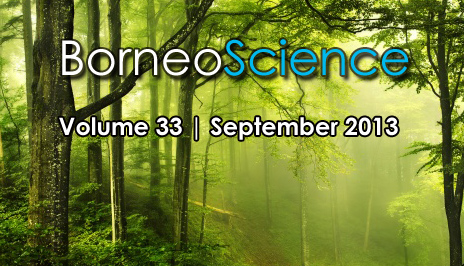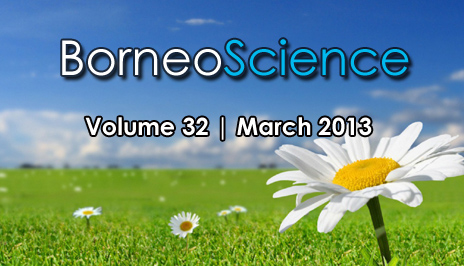Mohamed Ali Yusof Mohd Husin*, Hennie Fitria W. Soehady Erfen & Baba Musta
Faculty of Science & Natural Resources, Universiti Malaysia Sabah,
Jalan UMS, 88400 Kota Kinabalu, Sabah, Malaysia.
*E-mail address: mohamedaliyusof@yahoo.com
ABSTRACT. Heavy metals are one of the serious pollutants in environment because its toxicity. Severe concentration of heavy metals can harm the plants, animals and even human. During the pedogenesis process, heavy metals from the parent rock are mobilized in soils and redistribute in to the environment. The objective of this paper is to study the concentration and toxicity level of selected heavy metals in volcanic soils around Tawau, Sabah. In this study 10 soil samples were collected from different sampling stations. The selection of soil
samples were based on the different type of volcanic rocks in the study area. The determination of concentration of heavy metals in soil samples were carried out using X-Ray Fluorescence (XRF) analysis. The result shows, the highest concentration is chromium with the average of 141 ppm followed by zinc with 112 ppm. The concentration of copper is 49 ppm, nickel 15 ppm, lead 8 ppm and arsenic 7 ppm. The soil samples is identified as polluted due to the elevated concentration of certain heavy metals when compared with the Sediment Quality Guidelines of US EPA. Chromium is regarded as heavily polluted agent while zinc, copper and arsenic indicated that the area is moderately polluted. Nickel and lead average concentration show no indication of pollution in the area. It is concluded that the combined source of heavy metals in the study area would be the parent materials of the soils and other anthropogenic effluent. From the study also, it is found out that pH value, organic matter and clay percentage has influenced the heavy metal concentration in volcanic soil in the study area.
KEYWORDS. Heavy Metals, Tawau, Volcanic Soils, XRF.
REFERENCES
- Alloway, B.J. 1995. Heavy Metals in Soils 2nd Edition. Chapman and Hall.
- Alloway, B.J. 2008. Zinc in Soils and Crop Nutrition. International Zinc Association (IZA) & International Fertilizer Industry Association (IFA). BS 1377-1990. Methods of Test for Soils for Civil Engineering Purposes. London : British Standard Institution.
- Baba, M., Hennie F.W.S.E. & Sanudin, T. 2008. Geochemical Characterization of Volcanic Soils From Tawau, Sabah. Geological Society of Malaysia, Bulletin 54.
- Backer, D.E. & Chesnin, L. 1975. Chemical Monitoring of Soils For Environment Quality and Animal and Human Health. Adv. Agron. 27, 305–374.
- Baker, D.E. & Senft, J.P. 1995. Copper. In Alloway B.J. (ed.) Heavy Metals in Soils 2nd Edition, pp. 179-205. Glasgow: Chapman and Hall.
- Chen, Y.Y., Wang, J., Gao, W., Sun X.J. & Xu, S.Y. 2012. Comprehensive Analysis of Heavy Metals in Soils From Boashan District, Shanghai: a heavily industrialized area in China. Environmental Earth Science, Springer-Verlag.
- Islam, M.R., Stuart, R., Risto, A.,Vesa, P. 2001. Mineralogical changes during intense chemical weathering of sedimentary rocks in Bangladesh. Journal of Earth Sciences
20 (2002) 889-901. - Jenny, H. 1994. Factors of Soil Formation: A System of Quantitative Pedology. Dovers Publication, Inc.
- Kirk, H.J.C. 1962. The Geology and Mineral Resources of Semporna Peninsula. North Borneo Geology Survey Department British Territories in Borneo 14. Sarawak Government Printing Office.
- Kirk, H.J.C. 1968. The Igneous Rocks of Sarawak and Sabah. Geological Survey of Malaysia, Bulletin 5.
- McGarth, S.P. 1995. Chromium and Nickel. In Alloway B.J. (ed.) Heavy Metals in Soils 2nd Edition, pp. 152-178. Glasgow: Chapman and Hall.
- Matera, V., Le Hécho, I., Laboudigue, A., Thomas, P., Tellier, S. & Astruc, M. 2003. A Methodological Approach for The Identification of Arsenic Bearing Phases in Polluted Soils. Environmental Pollution 126 (2003) 51-64.
- Mason, B. 1958. Principles of Geochemistry, 2nd Edition. Wiley.
- Myung, C.J. 2008. Heavy Metal Concentrations in Soils and Factors Affecting Metal Uptake by Plants in The Vicinity of A Korean Cu-W Mine. Sensors 2008, 8, 2413-2423.
- Norrish, K. & Hutton, J.T. 1969. An Accurate X-Ray Spectographic Method For The Analysis of A Wide Range of Geological Samples. Geochem. Et Cosmochim. Acta, 33, 431 -453.
- Olade, M.A. 1987. Dispersion of Cadmium, Lead and Zinc in Soils and Sediments of a Humid Tropical Ecosystem in Nigeria. Lead, Mercury, Cadmium and Arsenic in The Environment, Scope. John Wiley & Sons Ltd.
- Pekey, H. 2006. Heavy Metal Pollution Assessment in Sediments of The Izmit Bay, Turkey. Environmental Monitoring and Assessment, Springer 123:219-231.
Perin, G., Bonardi, M., Fabris, R., Simoncini, B., Manente, S., Tosi, L. & Scotto, S. 1997. Heavy Metal Pollution in Central Venice Lagoon Bottom Sediments: Evaluation of Metal Bioavailability by Geochemical Speciation Procedure. Environmental Technology 18 593-604. - Prego, R. & Cobelo-Garcia, A. 2003. Twientieth Century Overview of Heavy Metals in The Galician Rias (NW Iberian Peninsular). Environmental Pollution, 121:425-425.
- Sabri, A.W., Rasheed, K.A. & Kassim, T.I. 1993. Heavy Metal in The Water, Suspended Solids and Sediment of The River Tigris Impoundment At Samarra. Journal of Water Research, 27:1099-1103.
- Saria, L., Takayuki, S. & Kentaro, M. 2006. Leaching of Heavy Metals in Acid Mine Drainage. Waste Management & Research, Vol. 24 No.2 134-140.
- Sanudin, T. & Baba, M. 2007. Pengenalan Kepada Stratigrafi. Penerbit UMS, Kota Kinabalu, Sabah.
- Schlotz, R. & Uhlig, S. 2006. Introduction to X-ray Flourescence Analysis (XRF). Bruker AXS GmbH, Karlruhe, West Germany.
- Shan, W., Xinghui X., Chunye L., Xi, C. & Chuanhui, Z. 2010. Levels of Arsenic and Heavy Metals in The Rural Soils of Beijing and Their Changes Ove The Last Two Decades (1985-2008). Journal of Hazardous Materials, 179:860-868.
- Sipos, P. 2004. Factors Affecting Heavy Metal Distribution in Forest Soils: Inherited Pedogenic Characteristics. Eurosoil 2004. Alvert-Ludwigs-Universitat Freiburg.


